

 
 


 
 
|
On the road to Kargil,
Dras
A salute to the spirit of infantrymen
By Amarinder
Singh
WHILE we continue to be glued to
our television sets as military spokesmen brief us on
day-to-day operations in Dras and Kargil, and while
newspapers are filled with pictures of soldiers in body
bags, and funerals taking place with full military
honours, our thoughts go out to the bereaved families of
our officers and men who died serving the nation.
An epitaph by A.E.
Housman comes to mind:
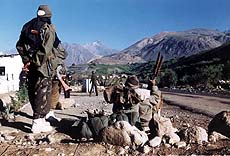 Here dead we lie, because we did not
choose to live and shame the land from which we sprung.
Life, to be sure, is nothing much to lose; But young men
think it is and we were young. Here dead we lie, because we did not
choose to live and shame the land from which we sprung.
Life, to be sure, is nothing much to lose; But young men
think it is and we were young.
While tales of courage
abound and officers and men continue to volunteer to
serve their country in the ongoing operations, what
perhaps fails to hit home to the average reader or viewer
is the inhospitable and desolate part of the country in
which our soldiers are operating and the extreme hardship
that they have to put up with.For those who have not seen
or had any experience of this terrain, it is a difficult
task to understand it.
The road fromSrinagar to
the Indus valley and Leh, the capital of Ladakh, passes
over the dominating Zoji La Pass at 11,432 feet.Starting
fromSrinagar, the road winds its way up the Sind valley
to Sonamarg, 52 miles to the north.From Sonamarg, a road
goes east to a village called Baltal, which stands on a
road junction.From here a road goes east up to the Zoji
La Pass and another to the south leads to the holy
Amarnath cave and further to the tourist resorts of Shesh
Nag and Pahalgam.
After crossing Zoji La,
situated on the rugged and virtually impassable Pangi
range, the road continues for 2 miles through an open
valley, at the same altitude,with craggy mountains as
high as 6,000 feet above the floor of the valley on
either side. The road then reaches an open plain called
Gumri which stands at the head of the Gumri Basin and at
the far end of which is Machoi.
From Machoi, the road
descends 8 miles to a large pasture called Minamarg at
the far end of which lies the first village east of the
Pass,Matyan. Five miles beyond Matyan is Pindras and
another 8 miles on is Dras, standing at 10,609 feet.This
is the coldest place in India. In winter, temperatures
occasionally fall as low as minus 50°C. There is no
vegetation of any type other than small alpine scrub and
bushes which can be seen occasionally as one drives
along.
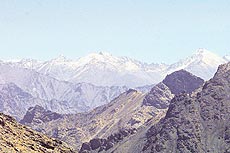 From
Matyan, a track leads to the north-east to the Mashkoh nullah
which finally ends up at Dras. FromDras, the road
continues to Kargil, then down to the Indus river. From
Matyan, a track leads to the north-east to the Mashkoh nullah
which finally ends up at Dras. FromDras, the road
continues to Kargil, then down to the Indus river.
The Pangi range, running
north-west and south-east of the Zoji La Pass, is
virtually an impenetrable barrier. Starting on the south
bank of the Indus river close to Gilgit, the first
prominent and dominating height is the massive mountain,
Nanga Parbat. Between the Nanga Parbat and the Zoji La
Pass, this impassable range permits just one crossing,
the Burzil Pass, which connects Gilgit to Gurais and then
down to the Kashmir valley. It is the area that was
captured in a gallant action by a two battalion group in
1948-- I Grenadiers and the 2/4 Gurkhas.
To the east of the Pangi
range lies the great Deosai plain in Baltistan.A plain
only in name as it is somewhat lower, but sharp craggy
mountains rise from it in steep jagged-edged ranges. Dras
and Kargil are situated on the south-eastern edge of this
plain, along the Srinagar-Leh road. The Deosai plain then
ends in the east, on the west bank of the Indus river.
To the east of the Indus
lies the Ladakh range and to the north of this the
Karakoram range on which is situated the famous Siachin
and Baltoro glaciers. Further north is the well-known
mountain, Mount K 2.
The only approach
fromPakistan into these rugged mountains dominating the
Srinagar-Leh highway is from Pakistan to Gilgit and then
along the Indus valley to Skardu. From here and from
Parkutta, Marol and other such small towns along the
Indus, all familiar names from the Kashmir operations of
1947/48, tracks penetrate the mountain ranges on the
Deosai plain and these too are few and far between.
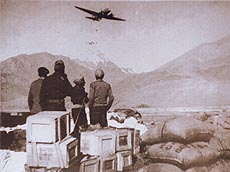 Those of us in our service days who have
had an opportunity of serving in these or similar areas,
are well aware of the impossibility of this type of
terrain. Patrols which we went on to reconoitre routes in
unchartered country ended up in nine cases out of ten
being abandoned, as one came up against sheer rock faces,
impassable even to trained mountain troops. Those of us in our service days who have
had an opportunity of serving in these or similar areas,
are well aware of the impossibility of this type of
terrain. Patrols which we went on to reconoitre routes in
unchartered country ended up in nine cases out of ten
being abandoned, as one came up against sheer rock faces,
impassable even to trained mountain troops.
Defensive positions
established on those mountain tops, which could be
reached by these few available tracks, had to rely
entirely on mules, and in some cases on human porterage,
when certain inclines mules too could not negotiate. All
this for the bare essentials of existence such as water
and food, not to mention heavy weapons and ammunition.
Sending unacclimatised troops to these heights led to its
own problem of mountain sickness (pulmonary oedema). Once
a soldier succumbs to this curse, he has to be
immediately evacuated to a lower altitude for treatment.
Death can also result in a matter of hours.
In May 1965, Pakistan
attempted one of its periodic forays into Indian
territory, the Rann of Kutch. The Indian Army responded
with operation Ablaze to push them out, which we
successfully did.While Kutch was the focus, the Army
Commander, Western Command, Lt Gen Harbaksh Singh, to
whom I was ADC, decided to tidy up our line and push the
enemy off two posts overlooking Kargil, Pt 13620 and
‘Black Rocks’. The 121 BrigadeGroup at Kargil
responded, and 4Rajput and 1 Guards captured both these
positions after bitter fighting and after taking heavy
casualties.I was in Kargil then and asked for permission
visit to a friend, then with1 Guards, Lt R.P. Singh
(since retired as a Major-General) up at ‘Black
Rocks’. I had recently left 4 Mountain Division
after having served for two years between 12,000 and
16,000 feet and I remember how steep and impossible that
climb was.
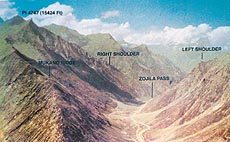 Today
we see press reports of ‘pincer’ movements and
other military jargon being bandied about by
well-intentioned, though militarily ill-informed,
journalists.Quick-moving armour battles may have
‘pincer’ or other movements but not where each
mountain has to be tackled separately. The old maxim
known to infantrymen since the grim and bloody battles of
the North West Frontier in the twenties and thirties is
that ‘those who hold the heights have already won
half the battle’ is the order of the day. Why we
lost these heights in the first place is another story
and some day we shall hear of it. In the meantime, each
mountain must be fought for, or if possible, isolated by
cutting off the means of supply, called ‘line of
communication’ (LoC) in military parlance, thereby
starving them at the top. Today
we see press reports of ‘pincer’ movements and
other military jargon being bandied about by
well-intentioned, though militarily ill-informed,
journalists.Quick-moving armour battles may have
‘pincer’ or other movements but not where each
mountain has to be tackled separately. The old maxim
known to infantrymen since the grim and bloody battles of
the North West Frontier in the twenties and thirties is
that ‘those who hold the heights have already won
half the battle’ is the order of the day. Why we
lost these heights in the first place is another story
and some day we shall hear of it. In the meantime, each
mountain must be fought for, or if possible, isolated by
cutting off the means of supply, called ‘line of
communication’ (LoC) in military parlance, thereby
starving them at the top.
Each mountain is perhaps
held by a section (10 men) or a platoon (40 men) and that
in itself is a formidable opposition. In virtually all
cases, one cannot deploy more than few men, perhaps a
section, along a razor-sharp ridge. The final approach as
one reaches the top where the enemy defences are would in
some cases be even narrower. In such cases, even a single
well-placed medium machine gun would be enough to wreak
havoc on an attacking force. In 1965, during the famous
"Haji Pir’ operations, three battalion attacks
on successive nights by 4 Rajput, 19 Punjab and 7 Bihar
on the formidable ‘Bedori’ feature held by a
platoon of Pakistan’s 6 Azad Kashmir failed. Once
again, the final approach was along a razor-sharp ridge.
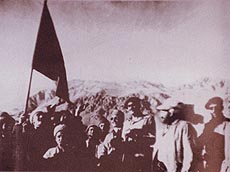 Infantrymen are perhaps the least
glorified soldiers of any operation of any army the world
over. In this age of speed and missile or laser
technology, air forces or swift armour operations appeal
more to an average civilian’s mind. In Kargil,
however, it is the infantrymen’s war and they
continue to fight relentlessly against heavy odds, the
elements, a well-entrenched enemy shooting down at him
while he struggles up the steep and rugged mountains
carrying loads of sixty to seventy pounds. Once wounded,
evacuation is an impossibility while the operation is on,
and many die quietly without urgent medical attention
being made available. Infantrymen are perhaps the least
glorified soldiers of any operation of any army the world
over. In this age of speed and missile or laser
technology, air forces or swift armour operations appeal
more to an average civilian’s mind. In Kargil,
however, it is the infantrymen’s war and they
continue to fight relentlessly against heavy odds, the
elements, a well-entrenched enemy shooting down at him
while he struggles up the steep and rugged mountains
carrying loads of sixty to seventy pounds. Once wounded,
evacuation is an impossibility while the operation is on,
and many die quietly without urgent medical attention
being made available.
General Francisco
Franco, the Spanish dictator in 1922, once described an
infantry soldier as follows: ‘Infantry men are they
who, in the frosts and storms of night, watch over the
sleep of camps, climb under fire the highest crests,
fight and die, without their voluntary sacrifice
receiving the reward of heroism’. How relevant it is
to Kargil 77 years later.
Today, there is a
general wave of support sweeping the country for our
defence forces, particularly the Army, in its most
difficult task. I have, however, witnessed such support
and sympathy in the wars of 1962, 1965 and 1971, but
sadly once operations are over, the soldier is forgotten.
There could be no finer tribute to his sacrifice than for
us to help the families of those who have fallen, not
only in the short term but to implement long-term
measures as well by providing education and later jobs to
their children. If each industry would adopt a couple of
families for this purpose, our dead would rest in peace.
We, that are left behind, owe it to them. If we do so, we
can feel satisfied that we have done our duty to the best
of our ability.
Laurence Binyon’s
immortal epitaph on the memorial to the unknown soldier
of the Great War of 1914/18, at London, aptly sums up the
national feeling today. The young officers, JCOs and men
of our army, who have laid down their lives and will
continue to do so till our territory is cleared of all
intrusion, must never be forgotten.
They shall not grow
old.
As we that are left grow old;
Age shall not weary them,
Nor the years condemn.
At the going down of the sun
and in the morning
We will remember them.
|

